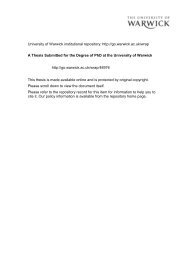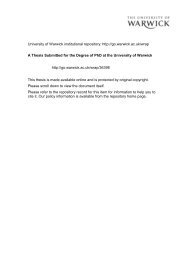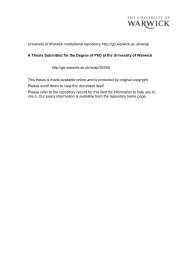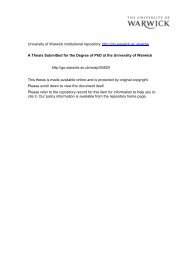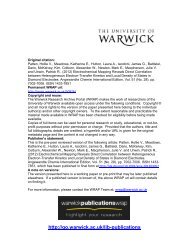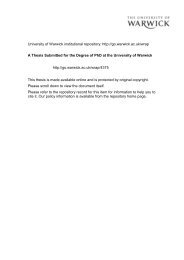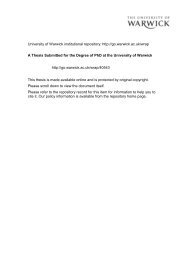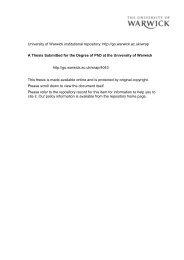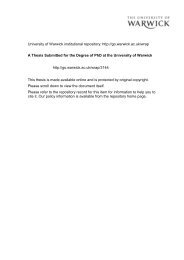Download (13Mb) - WRAP: Warwick Research Archive Portal ...
Download (13Mb) - WRAP: Warwick Research Archive Portal ...
Download (13Mb) - WRAP: Warwick Research Archive Portal ...
You also want an ePaper? Increase the reach of your titles
YUMPU automatically turns print PDFs into web optimized ePapers that Google loves.
writer - as a narrative space. The fantastic, which presupposes ruptures in the<br />
relationship between the self and its everyday world, is an appropriate mode in which<br />
to look for traces ofthis reconfiguration.<br />
The critic must work to foster ways of understanding women's writing if it is<br />
to be guaranteed a place in the literary mainstream, by developing a new language of<br />
criticism which is still widely regarded as absent. 32 Any contribution, however small,<br />
to the growing list of innovative studies of women's writing necessarily draws upon<br />
an eclectic synthesis of approaches to create this critical language. Making the<br />
connection between gender and writing shifts every critical approach to a text. In the<br />
first chapter therefore I attempt to tease out some ofthe individual threads which run<br />
through this particular study, marking out the ways in which they will be re-woven<br />
later in the study. First I develop a working theory ofthe fantastic for the purposes of<br />
this thesis. I allow this theory to be coloured by the texts themselves and examine the<br />
impact of space, both literal and cultural, in the development of the genre. I follow<br />
this with a brief survey of the history of the fantastic genre in Italy, and women<br />
writers' role in that history. Subsequently I look at contemporary theories of the<br />
female fantastic, considering the extent to which this genre may present Italian<br />
women writers with problems and possibilities for the forging of a relation to the<br />
canon. I look with particular interest at the chances of a dialogue with a femaleauthored<br />
canon, which have to date been relatively slight in Italy.33 Finally I examine<br />
briefly the relevance of psychoanalytical theory to an understanding of women<br />
writers' use ofthe fantastic as an intertextual space.<br />
In the second chapter I choose to concentrate upon the younger writer, Paola<br />
Capriolo, using her early work in particular as a litmus test. I believe that the<br />
difficulty she presents when one attempts to align her work with that ofother women<br />
writers is the key to understanding the textual space of the female fantastic. Her early<br />
32 'Cutrufelli argues that the patrimony of older women writers is less easily transferred because their<br />
works have always been studied according to non-literary criteria, including that of fmding their<br />
feminine qualities which are idiosyncratically defined and rarely in relationship to one another. Thus<br />
she recommends a genealogy of structures and forms that would show how women have expressed<br />
their political, sexual and personal concerns and how their writings differ from those of men. A<br />
genealogy constructed in this manner would be communicable, transmittable, and, above all, literary.'<br />
(Carol Lazzaro-Weis, p.52)<br />
33 As JoAnn Canon writes in Italian Women Writersfrom the Renaissance to the Present, 'Indeed,<br />
Rasy goes so far as to suggest that the tendency of women writers to look to the works ofother women<br />
writers as a natural point ofreference is one of the common threads linking all women writers. Whether<br />
contemporary Italian women writers will embrace this notion and defme themselves vis-a-vis other<br />
women writers remains to be seen.' (p.20)<br />
10




